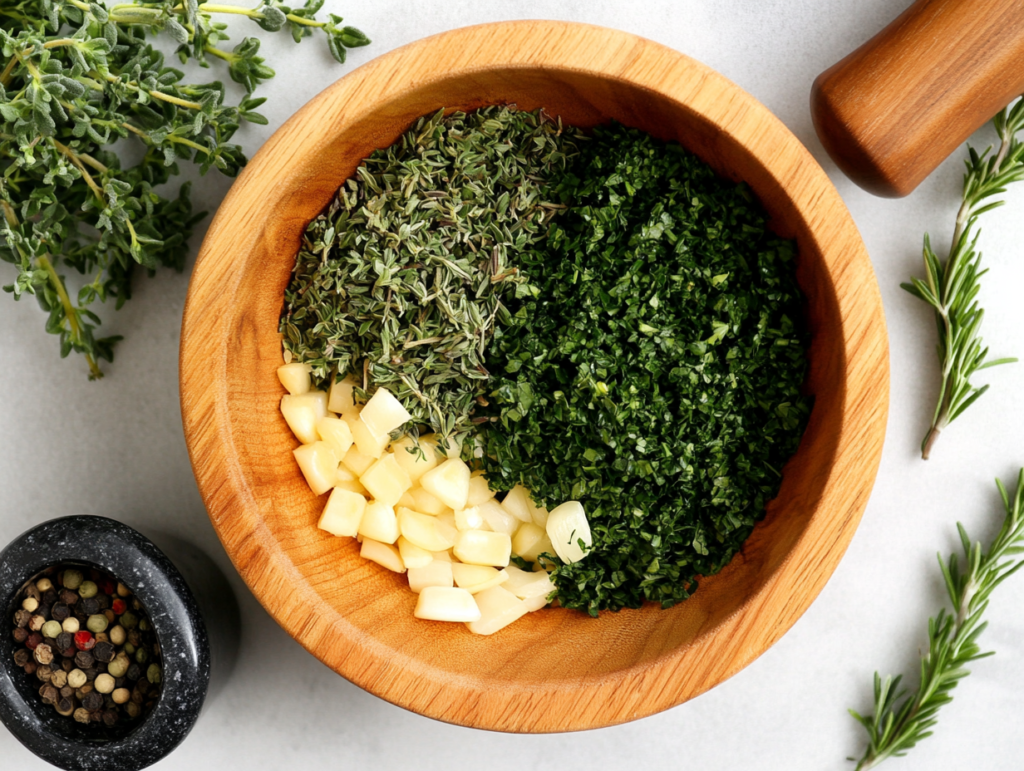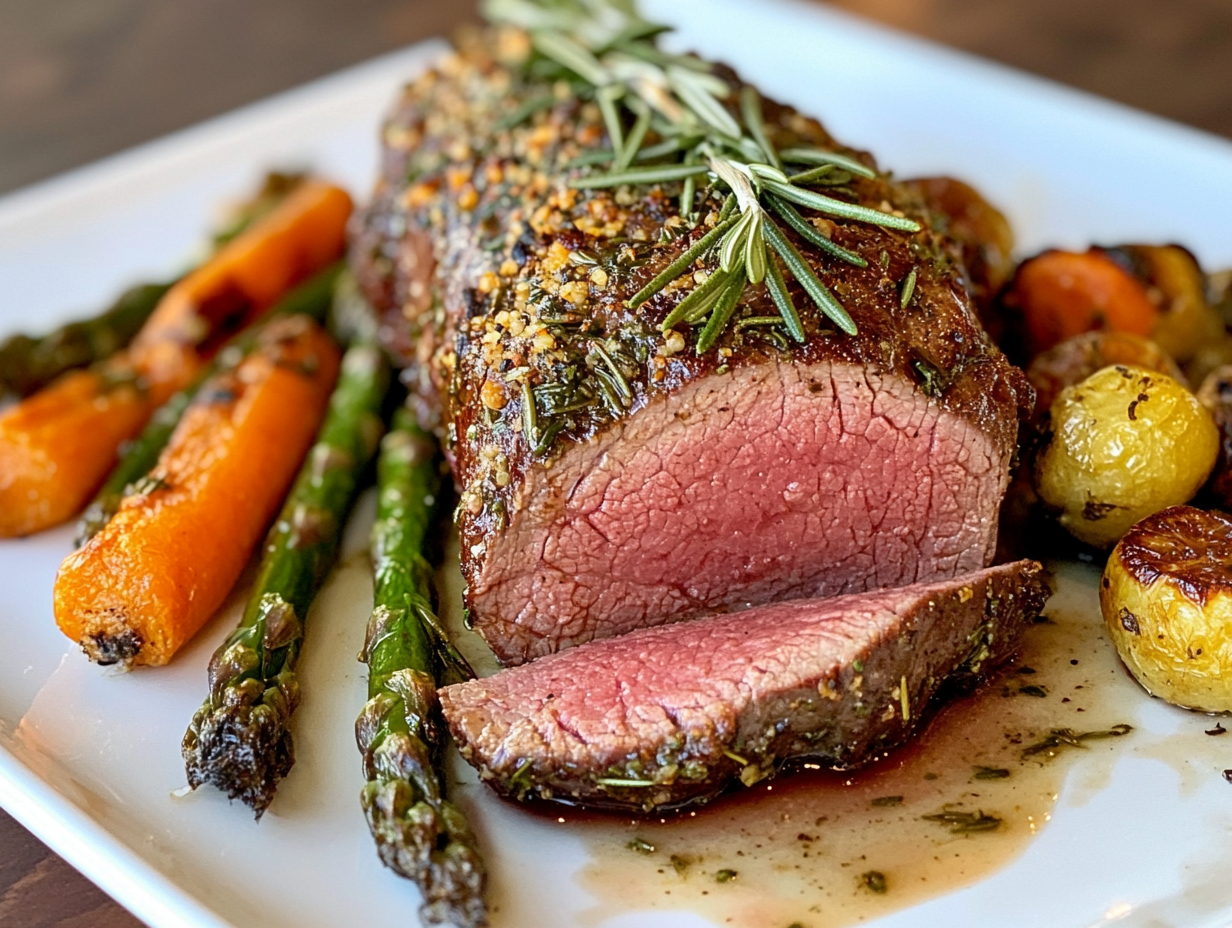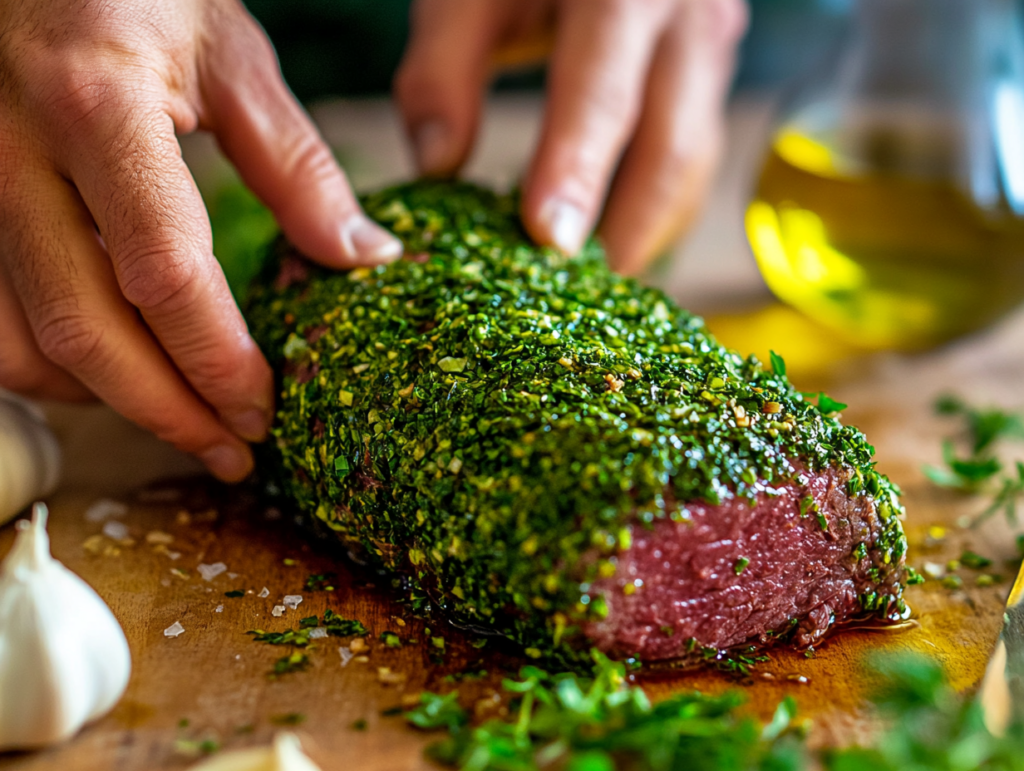Introduction
A perfectly roasted Herb-Crusted Beef Tenderloin is a showstopper dish, ideal for celebrations, holidays, or special dinners. With its tender texture and rich flavor enhanced by a fragrant herb crust, it’s a dish that impresses both in taste and presentation. Whether you’re hosting a formal dinner or looking to elevate your culinary skills, this guide will help you master every step of the process. From choosing the right cut to creating the perfect herb crust, you’ll learn how to prepare, cook, and serve a dish that’s guaranteed to leave a lasting impression.
For another festive roast idea, check out our Prime Rib Roast Recipe for a mouthwatering alternative.
Understanding Beef Tenderloin
What Is Beef Tenderloin?
Beef tenderloin is one of the most tender and luxurious cuts of beef, located along the cow’s backbone. This cut is prized for its buttery texture and subtle flavor, making it an excellent choice for roasting. It’s also the source of filet mignon, the smaller steaks cut from the tenderloin.
Different Cuts of Beef Tenderloin
- Whole Beef Tenderloin: Includes the head, center, and tail. Great for larger gatherings.
- Center-Cut Tenderloin: The most uniform and desirable part of the tenderloin, perfect for even cooking and presentation.
- Trimmed Tenderloin: Often prepped with excess fat and silverskin removed, ready to cook.
Hosting a mixed-diet gathering? Pair your tenderloin with our Vegetarian Nut Roast Recipe to delight all your guests.
Selecting the Best Beef Tenderloin
- Grade of Beef:
- USDA Prime offers the most marbling and flavor.
- USDA Choice is slightly leaner but still tender and delicious.
- Portion Size:
- Plan for 6–8 ounces per person if serving as a main course.
- Choose a size based on your guest list; a 4-pound tenderloin serves 8–10 people.
Preparing the Herb Crust
The herb crust is what elevates a Herb-Crusted Beef Tenderloin from a simple roast to an extraordinary dish. By combining fresh, aromatic herbs with complementary seasonings, you create a flavorful layer that enhances the beef’s natural richness.
Essential Herbs and Ingredients
To create the perfect herb crust, you’ll need these key ingredients:
- Fresh Herbs:
- Rosemary: Adds a woodsy, pine-like aroma.
- Thyme: Contributes a subtle earthiness.
- Parsley: Provides a fresh, vibrant flavor.
- Garlic: Minced garlic offers a pungent, savory base.
- Seasonings:
- Kosher salt for seasoning the meat evenly.
- Freshly ground black pepper for a bold, spicy kick.
- Binding Agent: Olive oil or melted butter helps the herb mixture adhere to the meat while adding moisture.
Creating the Perfect Herb Blend
- Finely chop rosemary, thyme, and parsley until you have about ½ cup of mixed herbs.
- Combine the herbs in a bowl with 4–5 cloves of minced garlic, 2 teaspoons of kosher salt, and 1 teaspoon of black pepper.
- Add 2–3 tablespoons of olive oil or melted butter to bind the ingredients into a spreadable paste.
For simpler roasting ideas, consider our flavorful Roast Chicken with Vegetables, perfect for everyday meals.
Tips for Customizing the Herb Mixture
- Add Zest: Incorporate lemon zest for a bright, citrusy twist.
- Include Spice: Mix in red pepper flakes for a hint of heat.
- Experiment with Herbs: Swap parsley for cilantro or add sage for a seasonal variation.

Preparing the Beef Tenderloin
Preparing the beef tenderloin is an essential step to ensure even cooking and optimal flavor. This involves trimming, tying, and applying the herb crust to create a visually stunning and delicious roast.
Trimming and Tying the Tenderloin
- Trimming the Tenderloin:
- Remove the silverskin (a tough membrane on the surface) using a sharp knife. Slide the knife under the silverskin, angling it slightly upward, and slice it off in long strips.
- Trim excess fat to create a smooth, uniform surface.
- Tying the Tenderloin:
- Use butcher’s twine to tie the tenderloin at 2-inch intervals along its length. This helps the roast maintain an even shape for consistent cooking.
- For a more cylindrical shape, fold the thinner tail section under and tie it securely.
Applying the Herb Crust
- Season the Tenderloin First:
- Pat the tenderloin dry with paper towels.
- Rub the meat generously with kosher salt and freshly ground black pepper to enhance the flavor of the beef itself.
- Spread the Herb Mixture:
- Evenly coat the surface of the tenderloin with the prepared herb paste. Use your hands or the back of a spoon to press the mixture firmly onto the meat, ensuring it sticks.
Marinating Time and Techniques
- Marinating Options:
- If time allows, let the herb-crusted tenderloin sit in the refrigerator for 1–2 hours to allow the flavors to meld. Cover loosely with plastic wrap.
- For an extra burst of flavor, prepare the tenderloin the night before and refrigerate overnight.
- Bringing to Room Temperature:
- Before cooking, remove the tenderloin from the refrigerator and let it sit at room temperature for 30–45 minutes. This ensures even cooking.
Cooking Methods
Cooking the Herb-Crusted Beef Tenderloin requires precision to achieve the perfect balance of a golden herb crust and a tender, juicy interior. Below are several methods to suit your preferences and equipment, each ensuring a spectacular result.
Oven-Roasting the Herb-Crusted Beef Tenderloin
Step-by-Step Instructions:
- Preheat the Oven:
- Set your oven to 425°F (220°C) for a perfectly seared crust while keeping the meat tender.
- Prepare the Tenderloin:
- Place the herb-crusted tenderloin on a wire rack over a roasting pan. The rack allows heat to circulate evenly, and the pan catches drippings.
- Initial High-Temperature Roast:
- Roast the tenderloin at 425°F for 15 minutes to create a golden crust.
- Lower the Temperature:
- Reduce the heat to 375°F (190°C) and continue roasting until the internal temperature reaches your desired doneness (see the temperature guide in the next section).
Grilling Techniques for Beef Tenderloin
Grill Setup:
- Preheat the grill and create a two-zone setup:
- One side should have direct heat for searing.
- The other side should have indirect heat for slower cooking.
Cooking Process:
- Sear the Tenderloin:
- Sear each side over direct heat for 2–3 minutes to lock in the flavors.
- Move to Indirect Heat:
- Transfer the tenderloin to the cooler side of the grill. Close the lid and cook until the desired internal temperature is reached. Rotate the tenderloin occasionally for even cooking.
Sous Vide Method for Precision Cooking
Why Choose Sous Vide?
Sous vide ensures precise control of the internal temperature, delivering consistently tender and evenly cooked results.
How to Cook Sous Vide:
- Season and Seal:
- Place the herb-crusted tenderloin in a vacuum-sealed bag or airtight sous vide bag.
- Set the Temperature:
- For medium-rare, set the sous vide machine to 132°F (56°C).
- Cook Time:
- Cook for 1.5–2 hours depending on the size of the tenderloin.
- Finish with a Sear:
- After sous vide cooking, pat the tenderloin dry and sear it in a hot skillet or under a broiler for 1–2 minutes on each side to create a crust.
Determining Doneness
Achieving the perfect doneness for your Herb-Crusted Beef Tenderloin is essential for creating a tender and juicy roast. Using a meat thermometer is the most accurate way to monitor internal temperature and ensure optimal results.
Using a Meat Thermometer
- Why It’s Important:
- A thermometer ensures the tenderloin is cooked to your preferred doneness without overcooking.
- How to Use It:
- Insert the thermometer into the thickest part of the tenderloin. Avoid touching the bone (if applicable) or the pan, as this can give inaccurate readings.
Temperature Guide for Desired Doneness
- Rare: 120–125°F (49–52°C)
- Medium-Rare: 130–135°F (54–57°C) (Recommended for beef tenderloin)
- Medium: 135–140°F (57–60°C)
- Well-Done: 145°F+ (63°C+)
Carryover Cooking:
- Remove the tenderloin from the heat when it’s 5–10°F below your target doneness. The internal temperature will continue to rise as the roast rests.
Resting the Meat Before Serving
- Why Resting Is Crucial:
- Resting allows the juices to redistribute, ensuring every slice is moist and flavorful.
- How to Rest:
- Tent the tenderloin loosely with aluminum foil and let it rest for 10–15 minutes before carving. This also helps the crust retain its crispness.
Serving Suggestions
Once your Herb-Crusted Beef Tenderloin is perfectly cooked and rested, presenting it with complementary side dishes and garnishes will elevate the meal. This section focuses on serving ideas to make your dish a centerpiece worthy of any occasion.
Ideal Side Dishes to Accompany Herb-Crusted Beef Tenderloin
- Potato-Based Sides:
- Garlic Mashed Potatoes: Creamy and buttery, the perfect comfort food pairing.
- Roasted Baby Potatoes: Crispy on the outside and soft on the inside, seasoned with rosemary and garlic.
- Vegetable Accompaniments:
- Roasted Asparagus: Lightly charred and seasoned with lemon zest.
- Glazed Carrots: Sweet and tender, with a honey or maple glaze.
- Green Beans Almondine: Sautéed green beans topped with toasted almonds for crunch.
- Grain Options:
- Wild rice pilaf or quinoa provides a hearty yet light pairing.
Sauce Pairings
- Red Wine Reduction: A savory sauce with rich, complex flavors to enhance the herb crust.
- Horseradish Cream Sauce: A tangy and creamy accompaniment that adds a hint of spice.
- Au Jus: A light, flavorful sauce made from the tenderloin’s drippings.
For a vegetarian-friendly addition, serve with our Vegetarian Nut Roast Recipe.
Presentation Tips for an Elegant Meal
- Plating the Tenderloin:
- Slice the tenderloin into even portions (about 1 inch thick) and arrange them on a large serving platter.
- Garnishing Ideas:
- Garnish the platter with sprigs of fresh rosemary, thyme, or parsley.
- Add roasted garlic cloves or lemon wedges for visual appeal.
- Serving Style:
- Place a spoonful of sauce beside or over the sliced tenderloin for a professional touch.
Storing and Reheating Leftovers
If you’re lucky enough to have leftovers from your Herb-Crusted Beef Tenderloin, proper storage and reheating will ensure the flavors and textures remain intact for future meals. Follow these tips for safely preserving and reheating your tenderloin without sacrificing quality.
Proper Storage Techniques
- Cool the Beef Safely:
- Allow the tenderloin to cool to room temperature for no more than 2 hours after cooking.
- Refrigeration:
- Wrap the tenderloin slices tightly in plastic wrap or aluminum foil.
- Place the wrapped slices in an airtight container to prevent drying out.
- Store in the refrigerator for up to 3–4 days.
- Freezing:
- For longer storage, wrap individual slices in plastic wrap, then place them in a freezer-safe bag or container.
- Label the bag with the date and consume within 2–3 months for best quality.
Reheating Methods to Maintain Juiciness
- Oven Method (Best for Large Portions):
- Preheat the oven to 300°F (150°C).
- Place the tenderloin slices in a baking dish with a splash of beef broth or water to retain moisture.
- Cover with aluminum foil and heat for 10–15 minutes or until warmed through.
- Stovetop Method (Quick and Effective):
- Heat a non-stick skillet over medium heat.
- Add a small amount of olive oil or butter and warm the slices for 1–2 minutes on each side.
- Microwave Method (For Convenience):
- Place slices on a microwave-safe plate and cover with a damp paper towel.
- Heat in 30-second intervals to avoid overcooking.
Creative Uses for Leftover Beef Tenderloin
- Sandwiches:
- Use the tenderloin slices to create a gourmet steak sandwich with horseradish cream and arugula on crusty bread.
- Stir-Fry:
- Dice the beef and toss it with vegetables and soy sauce for a quick and flavorful stir-fry.
- Salads:
- Add thin slices of tenderloin to a bed of mixed greens with cherry tomatoes, shaved Parmesan, and balsamic vinaigrette.
Frequently Asked Questions (FAQs)
Cooking a perfect Herb-Crusted Beef Tenderloin can raise a few questions, especially for first-timers. Here are answers to some of the most common queries to help you achieve success with this dish.
1. How long should I cook a beef tenderloin per pound?
- The cooking time depends on the size of the tenderloin and your desired doneness:
- Rare: 10–12 minutes per pound at 425°F (220°C).
- Medium-Rare: 12–14 minutes per pound at 425°F.
- Medium: 14–16 minutes per pound at 425°F.
- Use a meat thermometer for precise results.
2. Can I prepare the herb crust in advance?
- Yes! You can make the herb mixture up to 2 days in advance. Store it in an airtight container in the refrigerator. When ready to cook, apply it to the tenderloin as part of the preparation process.
3. What is the difference between beef tenderloin and filet mignon?
- Both cuts come from the tenderloin:
- Beef Tenderloin: Refers to the entire cut, which can be roasted as a whole.
- Filet Mignon: Small, individual steaks cut from the center of the tenderloin, typically cooked separately.
4. How do I prevent the herb crust from burning?
- To protect the herb crust:
- Lower the oven temperature after the initial high-heat sear.
- If necessary, loosely tent the tenderloin with aluminum foil while cooking to avoid over-browning.
5. Is it necessary to sear the beef tenderloin before roasting?
- Searing is not required but highly recommended. A quick sear in a hot skillet helps develop a flavorful crust, sealing in the juices and enhancing the roast’s texture and appearance.
Conclusion
Preparing a perfectly roasted Herb-Crusted Beef Tenderloin is a rewarding culinary experience that’s sure to impress your guests. With its tender texture, rich flavor, and aromatic herb crust, this dish is the ultimate choice for special occasions, holidays, or any time you want to elevate your meal.
Key Takeaways:
- Start with the Best Ingredients: Choose a high-quality beef tenderloin and fresh herbs for maximum flavor.
- Master the Preparation: Trim, tie, and season your tenderloin carefully to ensure even cooking and a flavorful herb crust.
- Cook with Precision: Use your preferred cooking method and a meat thermometer to achieve your desired level of doneness.
- Serve with Style: Pair the tenderloin with complementary sides and sauces, and present it elegantly to delight your guests.
By following this guide, you’ll be well on your way to creating a standout dish that will be the highlight of your table. Whether it’s your first time or a dish you’ve perfected over the years, Herb-Crusted Beef Tenderloin is a recipe worth adding to your repertoire.
Happy cooking! Let me know if you’d like additional tips, printable recipe cards, or visual guides to enhance this article further! 😊
For more roast inspiration, explore our Prime Rib Roast Recipe or discover plant-based brilliance with our Vegetarian Nut Roast Recipe. Happy cooking!


